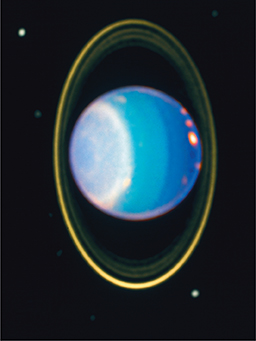25.4 The Outer Solar System
Reading Focus
Key Concepts
 How are the gas giants similar?
How are the gas giants similar? What are the characteristics of each of the outer planets?
What are the characteristics of each of the outer planets? What is a dwarf planet? What are comets and meteoroids?
What is a dwarf planet? What are comets and meteoroids? What lies in the outer solar system beyond Neptune?
What lies in the outer solar system beyond Neptune?
Vocabulary
gas giants
ring
Kuiper belt
Oort cloud
Reading Strategy
Summarizing Copy the table below and fill it in as you read to summarize characteristics of the outer planets. Expand the table to 4 rows.
Outer Planets |
Characteristics |
|---|---|
Jupite |
largest; most mass; most moons; Great Red Spot |
a. |
b. |
c. |
d. |
Scientific discovery happens in different ways. Sometimes things are discovered by accident. At other times, theories predict phenome na that scientists then try to find. The discoveries of Uranus (YOOR uh nus) and Neptune are examples of these two different methods. Unlike Jupiter and Saturn, which appear very bright in the night sky and have been observed for thousands of years, Uranus and Neptune were unknown to ancient observers.
Uranus, shown in Figure 19, was discovered by chance. In 1781, astronomer William Herschel was studying the sky with a telescope when he saw a fuzzy object that he first thought was a comet. Other astronomers had observed Uranus before but had incorrectly identified it as a dim star. Herschel tracked Uranus's position for almost a year before he realized it was a planet.
Over the next 50 years, astronomers noticed that Uranus was not following its predicted orbit. Working independently, mathematicians John Adams of England and Urbain Le Verrier of France concluded that there must be another planet, farther from the sun, whose gravity was affecting Uranus. Each predicted the location in the sky where this new planet should be. In 1846, the planet Neptune was discovered, very near where they had predicted.
Figure 19 Uranus was discovered in 1781, but its rings were not found until 1977. Like Uranus itself, the rings were discovered by accident. This false-color infrared image was taken by the Hubble Space Telescope.






